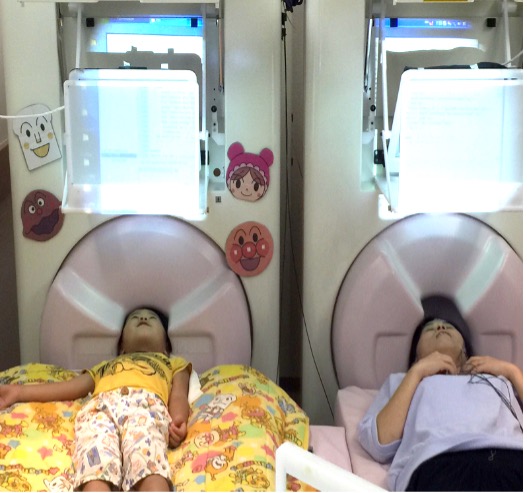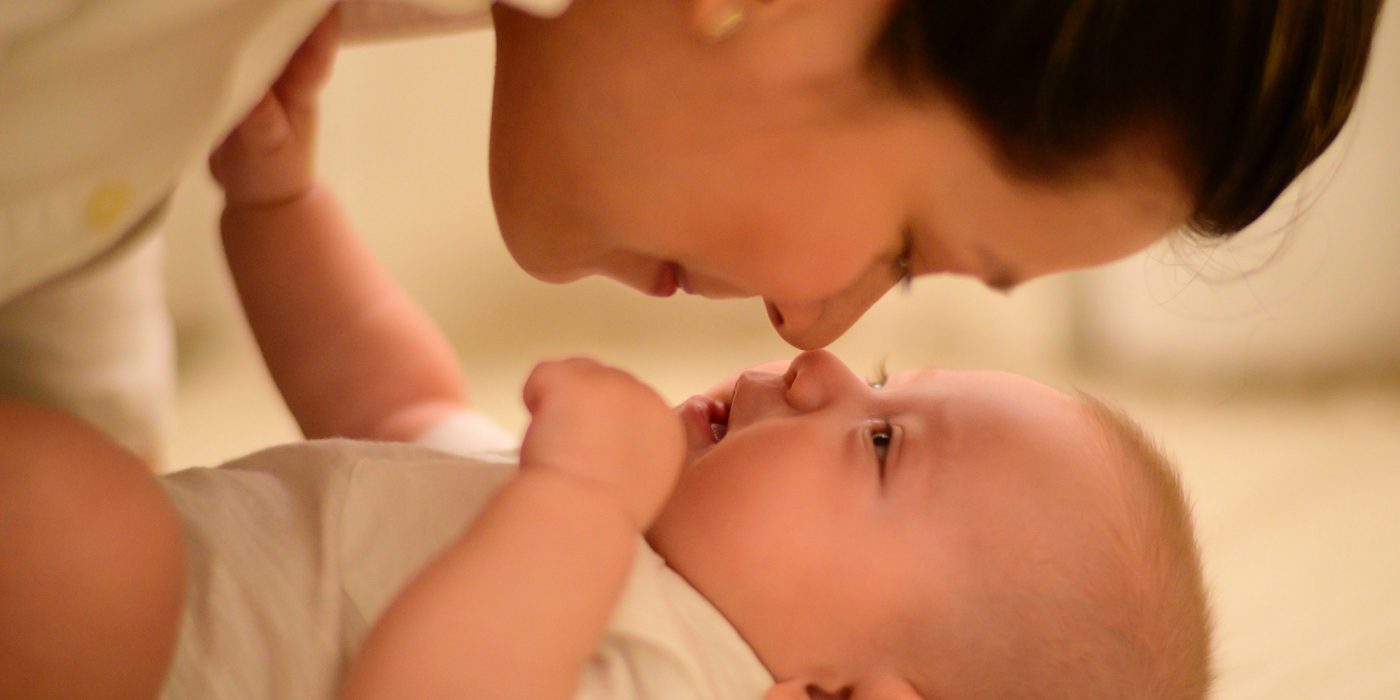We’ve all had the experience of feeling “in synch” with another person, and mothers frequently describe feeling a “psychic connection” with their children. Groundbreaking new research from the University of Washington’s Institute for Brain and Learning Sciences (I-LABS) indicates that these descriptions are more than handy metaphors.

In an experiment that’s the first of its kind in the world, I-LABS, in collaboration with Japanese and Taiwanese brain scientists, conducted a study of the neural connection between mothers and their 5-year-old children using dual MEG brain-imaging devices. MEG, or magnetoencephalography, is a safe, silent, precise technique for investigating human brain activity. The ultra-high-tech device allows brain activity to be measured millisecond-by-millisecond and maps down to the millimeter where in the brain that activity is produced.
Previous research by I-LABS scientists has shown that verbal turn-taking and imitation are essential in young children’s language learning and social development, and that their language learning happens only via social interaction with other people. But how parents and children coordinate their brain activity during these social interactions has been an intriguing mystery. With the development of a dual-MEG setup, it has become possible to observe those interactions in real time right where they’re happening in the brains of mother-child pairs.
“Humans are social creatures, and we evolved to learn from one another,” says Dr. Patricia Kuhl, I-LABS’ co-director, who holds the Bezos Family Foundation Endowed Chair in Early Childhood Learning. “So now the big question is how our brains do that, how they exchange information and learn and feed off each other. Understanding that is complicated from the experimental standpoint.”
In the article “Dual-MEG interbrain synchronization during turn-taking verbal interactions between mothers and children,” published this summer in the journal Cerebral Cortex, lead author Jo-Fu Lotus Lin, a researcher from National Tsing Hua University in Taiwan with an appointment at Japan’s Kanazawa University, details the history of testing two interactive individuals simultaneously. During the last 15 years or so, simultaneous recordings of brain activity have been observed using less precise measuring techniques. The advent of MEG has made it possible to precisely pinpoint the regions of the brain that light up during interpersonal interactions. (Until recently, the MEG lab in Japan has been the only one in the world with two MEG machines; I-LABS has now become the only lab in the world with two MEG machines, one of which is a “wearable” MEG machine, which Kuhl says will open whole new worlds of social neuroscience research.)
For the dual-MEG mother-child study, Kuhl says, each pair of mothers and their 5-year-olds lay next to each other in their respective MEG machines. The mothers then read a phrase and the child imitated the intonation and words of that phrase. As a control, mother and child listened passively to pure tones.
“With the MEG machines, we’re able to see what’s happening in the mother’s brain and the child’s brain during the social interaction,” Kuhl says, “and what we see is neurons firing in areas of the brain related to attention and learning at the same rate in mother and child. The neurons are doing a dance together at the same rhythm at the same time in the same places in these two brains.”
It was a moment of amazement for the researchers, Kuhl says.
Although the study was admittedly “pretty cool,” Kuhl says the research is just getting started. Now that I-LABS has the wearable MEG as well as the traditional one, the plan is to study parents and 5 ½ month-old babies. Fathers will be part of the study for the first time, she says, and researchers will measure the social interaction of mom with the baby and then dad and baby when they are interacting face-to-face.
Another exciting layer to the experiment will be to test the parents’ natural levels of oxytocin before and after the social interaction to see if adults who have more oxytocin have more neural synchrony with their child. Oxytocin has sometimes been called the “love hormone” because of the role it plays in social bonding.
The wearable MEG will allow the parent to interact with the baby in more normal face-to-face interaction. The parent will engage with the child and then turn away to engage with someone outside the child’s periphery to see what happens to that neural synchrony when the parent’s attention temporarily turns in a different direction.
What the study won’t do is have the parents completely ignore the baby and focus entirely on their cellphones. The researchers had considered doing such a study but stopped it before it really got under way.
“Right before the pandemic, we were setting one up with the mom moving her attention completely from the baby to focus entirely on the cellphone,” Kuhl says. “It upset the babies so much we said, ‘Nope. Can’t run that experiment.’ The one we’re setting up now—where the mother rotates to another person—happens all the time in the real world and the baby will try to get her attention back. The phone thing really tended to upset the babies.”
One of the long-term goals of the newest research is to see whether the social connection represented by neural synchrony predicts other positive outcomes in a child’s life, such as mother-infant attachment.

“I think we’ll see that it affects the learning of language,” Kuhl says. “I think we’ll see that social interaction is the seat of language—which is a fairly radical view. I think social interaction is the instigator, and connections between adults and infants precede and predict rapid language learning because language is so necessarily social. What comes first is this attraction between parent and child, this intense attention being paid where the baby is glued to their faces and voices and that input changes their brain.”
In the dual-MEG study, Japanese researchers had the mothers and their 5-year-olds playing an imitation game, in which the mother would change the pitch of her voice and the child would try to mimic it. The role of neural synchrony prompted by imitation is an important one in human evolution, Kuhl says, and the tangible evidence of that dance is thrilling.
“That initial connection is how babies know that they’re one of us, that they have bodies like us and that they belong,” she says. “If you raise your finger and the baby imitates that or open your mouth and the baby does that back to you, that’s the baby relating to members of the group and saying, ‘I’m like you.’ That’s a very critical connection.”
Our society has given short shrift to social needs and the degree to which social interaction influences learning. Kuhl’s hope is that the research she and others are doing on brain synchrony will help put to rest the idea that social connection is “just soft and fuzzy.”
“It’s not just playing. It’s not being nice or just giving hugs,” she says. “Social connection is a conduit for knowledge—all of our cognitive, linguistic and social development, all our cultural institutions come through the social brain.
“There’s so much more to know—about that neural synchrony in other relationships, for instance. If you have a teacher relating to a group of students and for some there’s that ‘Aha!’ moment where they say, ‘Oh, I get it. Chemistry works like this…,’ maybe that’s the same sort of synchrony. Maybe it’s quite common—maybe between husband and wife or two students working on a project together.
“With the new MEG technology, this is a field of work that’s only going to grow,” Kuhl says. “We’re just beginning to chip away at the magic that might be happening when we’re in face to face contact.”

K.C. Compton
K.C. Compton worked as a reporter, editor and columnist for newspapers throughout the Rocky Mountain region for 20 years before moving to the Kansas City area as an editor for Mother Earth News. She has been in Seattle since 2016, enjoying life as a freelance and contract writer and editor.



